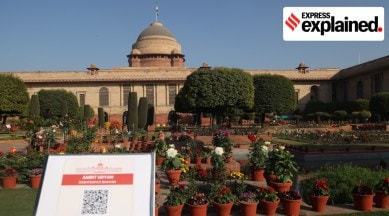Rashtrapati Bhavan’s Mughal Gardens renamed as Amrit Udyan: A brief history
Often described as the Rashtrapati Bhavan’s soul, the 15-acre garden will now be called “Amrit Udyan”. Here is a brief history of the erstwhile Mughal Gardens.

The iconic Mughal Gardens at the Rashtrapati Bhavan (President’s House) in Delhi have been renamed. “The collective identity of all the gardens at Rashtrapati Bhavan will be ‘Amrit Udyan’. Earlier there were descriptive identities, now a new identity has been given to the gardens,” said Ajay Singh, the President’s press secretary, as reported by ANI.
The gardens will open to the public on January 31, ANI reported. The renaming has drawn a mixed response, with some calling it “long overdue”, while others claim it is yet another instance of petty politics.
A long history of Mughal Gardens in India
The Mughals were known to appreciate gardens. In Babur Nama, Babur says that his favourite kind of garden is the Persian charbagh style (literally, four gardens). The charbagh structure was intended to create a representation of an earthly utopia – jannat – in which humans co-exist in perfect harmony with all elements of nature.
Defined by its rectilinear layouts, divided in four equal sections, these gardens can be found across lands previously ruled by the Mughals. From the gardens surrounding Humanyun’s Tomb in Delhi to the Nishat Bagh in Srinagar, all are built in this style – giving them the moniker of Mughal Gardens.
A defining feature of these gardens is the use of waterways, often to demarcate the various quadrants of the garden. These were not only crucial to maintain the flora of the garden, they also were an important part of its aesthetic. Fountains were often built, symbolising the “cycle of life.”
The gardens at the new Viceroy’s house
In 1911, the British decided to shift the Indian capital from Calcutta to Delhi. This would be a mammoth exercise, involving the construction of a whole new city – New Delhi – that would be built as the British Crown’s seat of power in its most valuable colony.
About 4,000 acres of land was acquired to construct the Viceroy’s House with Sir Edwin Lutyens being given the task of designing the building on Raisina Hill. Lutyens’ designs combined elements of classical European architecture with Indian styles, producing a unique aesthetic that defines Lutyens’ Delhi till date.
Crucial in the design of the Viceroy’s House was a large garden in its rear. While initial plans involved creating a garden with traditional British sensibilities in mind, Lady Hardinge, the wife of the then Viceroy, urged planners to create a Mughal-style garden. It is said that she was inspired by the book Gardens of the Great Mughals (1913) by Constance Villiers-Stuart as well as her visits to the Mughal gardens in Lahore and Srinagar.
The famous roses of the garden
Though the layout of the garden was in place by 1917, the planting was taken up only in 1928-29. Director of horticulture William Mustoe, who planted the garden, was especially skilled at growing roses and is said to have introduced more than 250 different varieties of hybrid roses gathered from every corner of the world. Lady Beatrix Stanley, a prominent horticulturist, noted in 1931 that she had not seen better roses in England. Later, more variety was added, especially during the presidency of Dr Zakir Husain.
The gardeners of the Rashtrapati Bhavan have kept alive the tradition of nurturing the defining feature of the gardens — the multitude of rose varieties. They include Adora, Mrinalini, Taj Mahal, Eiffel Tower, Scentimental, Oklahoma (also called Black Rose), Black Lady, Blue Moon and Lady X. There are also roses named after personalities: Mother Teresa, Raja Ram Mohan Roy, Abraham Lincoln, Jawahar Lal Nehru, and Queen Elizabeth — not to forget Arjun and Bhim. The ingenious gardeners also introduced new, exotic varieties of flowers like birds of paradise, tulips and heliconia in 1998.
Each resident of the Rashtrapati Bhavan leaves their own touch
The gardens have evolved over time. While roses remain the star attraction, residents of the Rashtrapati Bhavan have all added their own personal touch to the garden.
For instance, C Rajagopalachari, the last Governor General of India, made a political statement when during a period of food shortage in the country, he himself ploughed the lands and dedicated a section of the garden to foodgrains. Today, the Nutrition Garden, popularly known as Dalikhana, stands in that spot, organically cultivating a variety of vegetables for consumption at the Rashtrapati Bhavan.
President R Venkatraman added a cactus garden (he just liked cacti) and APJ Abdul Kalam added many theme-based gardens: from the musical garden to the spiritual garden.